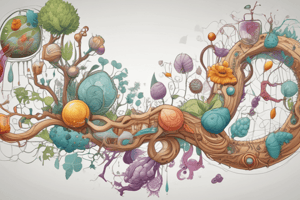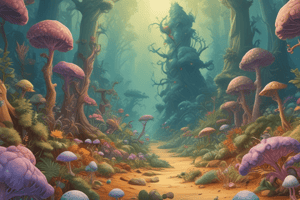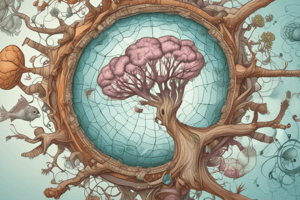Podcast
Questions and Answers
What is the study of the interactions between organisms and their environment?
What is the study of the interactions between organisms and their environment?
- Biochemistry
- Botany
- Genetics
- Ecology (correct)
What is the global sum of all ecosystems on Earth?
What is the global sum of all ecosystems on Earth?
- Ecosystem
- Biosphere (correct)
- Population
- Community
What is the process by which organisms adjust to their environment?
What is the process by which organisms adjust to their environment?
- Evolution
- Photosynthesis
- Adaptation (correct)
- Homeostasis
What is the study of the structure, function, and growth of microorganisms?
What is the study of the structure, function, and growth of microorganisms?
What are the basic building blocks of life?
What are the basic building blocks of life?
What is the process by which cells generate energy from glucose?
What is the process by which cells generate energy from glucose?
What are the molecules that store and transmit genetic information?
What are the molecules that store and transmit genetic information?
What is the maintenance of a stable internal environment despite external changes?
What is the maintenance of a stable internal environment despite external changes?
Flashcards are hidden until you start studying
Study Notes
Definition and Scope
- Biology is the scientific study of life and living organisms, including their structure, function, growth, evolution, distribution, and taxonomy.
- It explores the diversity of life forms, from molecules to ecosystems.
Branches of Biology
- Botany: study of plants
- Zoology: study of animals
- Microbiology: study of microorganisms
- Ecology: study of interactions between organisms and their environment
- Genetics: study of heredity and variation
- Biochemistry: study of chemical processes in living organisms
- Biophysics: study of physical principles underlying biological processes
- Molecular Biology: study of biological molecules and their interactions
Levels of Organization
- Molecules: basic building blocks of life (e.g., proteins, carbohydrates, nucleic acids)
- Cells: basic structural and functional units of life
- Tissues: groups of similar cells performing specific functions
- Organs: structures composed of multiple tissues performing specific functions
- Organ Systems: groups of organs working together to maintain homeostasis
- Organisms: individual living entities (e.g., humans, plants, animals)
- Populations: groups of individuals of the same species
- Communities: groups of different species interacting in a specific area
- Ecosystems: interactions between living and non-living components in a specific area
- Biosphere: global sum of all ecosystems on Earth
Central Concepts
- Homeostasis: maintenance of a stable internal environment despite external changes
- Adaptation: process by which organisms adjust to their environment
- Evolution: change in species over time through natural selection and genetic drift
- Photosynthesis: process by which plants convert light energy into chemical energy
- Cellular Respiration: process by which cells generate energy from glucose
Biological Molecules
- Carbohydrates: provide energy and structural support
- Proteins: perform various functions (e.g., enzymes, hormones, structural components)
- Nucleic Acids: store and transmit genetic information (DNA, RNA)
- Lipids: provide energy, structural support, and aid in cellular processes
Definition and Scope
- Biology studies life, including the structure, function, growth, evolution, distribution, and taxonomy of organisms.
- It encompasses the diversity of life from molecular levels to entire ecosystems.
Branches of Biology
- Botany focuses on plant life and processes.
- Zoology investigates animal life and behavior.
- Microbiology centers on microscopic organisms, including bacteria and viruses.
- Ecology examines interactions between organisms and their non-living environment.
- Genetics explores heredity, genetic variation, and the role of genes in living organisms.
- Biochemistry analyzes chemical processes and substances within living organisms.
- Biophysics applies physical principles to biological systems.
- Molecular Biology studies the molecular mechanisms of biological processes and interactions.
Levels of Organization
- Molecules are the fundamental units of life, including proteins, carbohydrates, and nucleic acids.
- Cells are the basic structural and functional units of life, capable of performing all essential life processes.
- Tissues are specialized groups of similar cells that serve specific functions within organisms.
- Organs are complex structures formed by different tissues working together to perform specific functions.
- Organ Systems consist of groups of organs that collaborate to maintain homeostasis and support the organism's life processes.
- Organisms refer to individual living entities like humans, plants, and animals.
- Populations consist of groups of individuals from the same species living in a specific area.
- Communities comprise different species interacting in a shared environment.
- Ecosystems involve the relationships between living organisms and their physical environment.
- The Biosphere represents the global sum of all ecosystems on Earth, supporting life.
Central Concepts
- Homeostasis is vital for maintaining a stable internal environment despite external fluctuations.
- Adaptation allows organisms to modify their behaviors and traits in response to environmental changes.
- Evolution signifies the gradual change of species over time, driven by natural selection and genetic drift.
- Photosynthesis enables plants to convert sunlight into chemical energy, supporting life on Earth.
- Cellular Respiration is the process through which cells extract energy from glucose for metabolic activities.
Biological Molecules
- Carbohydrates are essential for energy provision and offering structural support to cells.
- Proteins have diverse functions, including serving as enzymes, hormones, and structural components.
- Nucleic Acids, such as DNA and RNA, are critical for storing and transmitting genetic information.
- Lipids play roles in energy storage, structural integrity of cell membranes, and facilitation of cellular processes.
Studying That Suits You
Use AI to generate personalized quizzes and flashcards to suit your learning preferences.





